Facilities
- Car park
Restrictions
- Challenging Access
Abbeyknockmoy Cistercian Abbey is a state-owned National Monument in the care of the Office of Public Works
*car park is located a short walk away near the graveyard / There is a stile to get through for access, over a fence via steps*
WARNING: It should be noted that these sites are unguided and a level of care and caution should be maintained during all stages of your visit. The Office Of Public Works (OPW) will not be held responsible for any damages, injuries, or losses that occur
Knockmoy Abbey (Mainistir Chnoc Muaidhe in Irish), also known as The Monastery of the Hill of Victory (Monasterium Collis Victoriæ in Latin), is a ruined Cistercian ecclesiastical complex located on the northern bank of the Abbert River in north east Co. Galway. It lies 12.5 kilometres south east of the town of Tuam and one kilometre north east of the village of Abbeyknockmoy.
The abbey was founded in 1189/1190 by Cathal Crobhdearg Ua Conchobair (Charles "Red Hand" O’Connor) (1153–1224), the much-feared King of Connaught whose bloody reign lasted for thirty six years. Following the death in 1217/1218 of his wife Mór Ní Briain, a daughter of King Domhnall Mór Ua Briain of Thomond, he was buried alongside her in the abbey on the 27th May 1224, in, according to the Annals of Connacht, the habit of a Franciscan Greyfriar.
The abbey was settled by monks from its sister house of Boyle Abbey in Co. Roscommon. It was plundered in 1202 by William De Burgo and again in 1228. In 1240 the Abbot was censured for having his hair washed by a woman, and in 1483 the Abbot was accused of setting fire to the abbey.
Following the dissolution of the monasteries in the 16th century, the Abbot-in-Commendam, Hugh O’Kelly, surrendered the abbey, on the 24th May 1542, to the English king Henry VIII. O’Kelly was appointed as rent collector and the abbey’s church remained as the parish church, becoming known as Porta Magna (Great Door) and Teampollandorusmoir (The Chapel with the Big Door).
Although the majority of the buildings that constitute the abbey date from the early 13th century, there is evidence that additional building occurred in both the 15th and 16th centuries. The monastery’s church has a wide nave, a chancel, and narrow transepts to the north and south containing two side chapels. The rib-vaulted chancel has fine carved capitals and an east-facing window. The laybrothers of the abbey would worship in the nave, while the monks would worship in the chancel.
The sculpted head of a king, possibly Cathal Crobhdearg Ua Conchobair, whose nose and chin are missing but whose eyes, hair and crown survive, can be seen in the southwest corner of the church. A small number of other elegant carvings can also be found in the ruins.
Dormitories were located above both the vaulted-ceilinged sacristy and the chancel. An original three-light window, with elaborately moulded jambs, as well as later two single-light windows, with rubble-work lambs, are features in the vaulted chapter room. This room is divided by cross-walls into three sections.
A calefactory, or monks’ day room, sits to the south of the chapter room and there is a refectory at the south end of the church. Novices' rooms are believed to have been located to the south east of the refectory. The abbey ruins surround a cloister on its north, east and south sides, in which now are located some local graves and gravestones.
Housing one of only four such artworks in Ireland, and of very special importance, Knockmoy Abbey is known for its tempera wall-paintings, which once covered the entire north end of the chancel of the abbey's church. Estimated to date from 15th century, they were reproduced as engravings in Edward Ledwich’s 'Antiquities of Ireland' in 1790, and were copied and displayed at the Dublin Exhibition in 1853. To protect these rare images, in the 1980s the Office of Public Works weather-proofed that part of the abbey which houses them.
Also in the abbey is a beautifully carved memorial plaque to Elevina Kirwan, the second wife of Robert French of Monivae, Co. Galway. Dated to the 8th August 1684, it contains her armorial bearing, along with the motto "Laus Deo" ("Praise be to God").
Visit Historic Environment Viewer and Monastic Ireland for more information on Abbeyknockmoy
Protect our Past - Click here to read about the importance of protecting our country’s unique heritage sites
This national monument is protected in accordance with the National Monuments Acts 1930 to 2014
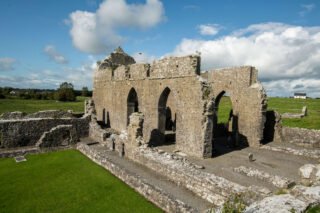

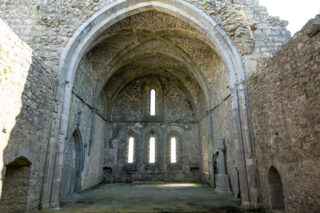
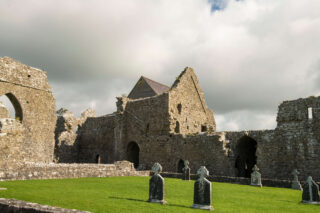
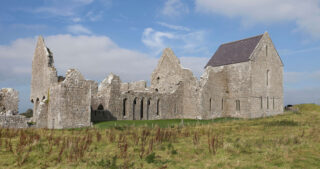
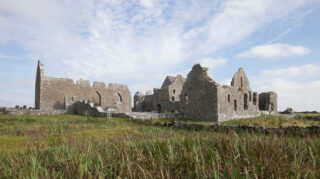
An emblem of Norman lordship
Approx. 15.6 km from Abbeyknockmoy Cistercian Abbey
A historical gem in the heart of Connemara
Approx. 35.4 km from Abbeyknockmoy Cistercian Abbey
A dramatic and imposing thirteenth Century Norman Castle
Approx. 42.1 km from Abbeyknockmoy Cistercian Abbey
Follow in the footsteps of Queen Medb at Connacht’s ancient capital
Approx. 49.6 km from Abbeyknockmoy Cistercian Abbey
A spectacular monastery on the banks of the river Shannon
Approx. 51.8 km from Abbeyknockmoy Cistercian Abbey
Seventeenth-century splendour on the shores of Lough Derg
Approx. 52.5 km from Abbeyknockmoy Cistercian Abbey